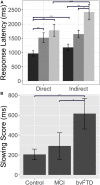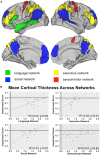More Than Words: Extra-Sylvian Neuroanatomic Networks Support Indirect Speech Act Comprehension and Discourse in Behavioral Variant Frontotemporal Dementia
- PMID: 33519400
- PMCID: PMC7842266
- DOI: 10.3389/fnhum.2020.598131
More Than Words: Extra-Sylvian Neuroanatomic Networks Support Indirect Speech Act Comprehension and Discourse in Behavioral Variant Frontotemporal Dementia
Abstract
Indirect speech acts-responding "I forgot to wear my watch today" to someone who asked for the time-are ubiquitous in daily conversation, but are understudied in current neurobiological models of language. To comprehend an indirect speech act like this one, listeners must not only decode the lexical-semantic content of the utterance, but also make a pragmatic, bridging inference. This inference allows listeners to derive the speaker's true, intended meaning-in the above dialog, for example, that the speaker cannot provide the time. In the present work, we address this major gap by asking non-aphasic patients with behavioral variant frontotemporal dementia (bvFTD, n = 21) and brain-damaged controls with amnestic mild cognitive impairment (MCI, n = 17) to judge simple question-answer dialogs of the form: "Do you want some cake for dessert?" "I'm on a very strict diet right now," and relate the results to structural and diffusion MRI. Accuracy and reaction time results demonstrate that subjects with bvFTD, but not MCI, are selectively impaired in indirect relative to direct speech act comprehension, due in part to their social and executive limitations, and performance is related to caregivers' judgment of communication efficacy. MRI imaging associates the observed impairment in bvFTD to cortical thinning not only in traditional language-associated regions, but also in fronto-parietal regions implicated in social and executive cerebral networks. Finally, diffusion tensor imaging analyses implicate white matter tracts in both dorsal and ventral projection streams, including superior longitudinal fasciculus, frontal aslant, and uncinate fasciculus. These results have strong implications for updated neurobiological models of language, and emphasize a core, language-mediated social disorder in patients with bvFTD.
Keywords: behavioral variant frontotemporal dementia; comprehension; discourse; frontal lobe; frontotemporal dementia; inferencing; white matter tractography.
Copyright © 2021 Healey, Howard, Ungrady, Olm, Nevler, Irwin and Grossman.
Conflict of interest statement
The authors declare that the research was conducted in the absence of any commercial or financial relationships that could be construed as a potential conflict of interest.
Figures





Similar articles
-
The neural bases of discourse semantic and pragmatic deficits in patients with frontotemporal dementia and Alzheimer's disease.Cortex. 2020 Jul;128:174-191. doi: 10.1016/j.cortex.2020.03.012. Epub 2020 Mar 31. Cortex. 2020. PMID: 32353756
-
Multiparametric MRI to distinguish early onset Alzheimer's disease and behavioural variant of frontotemporal dementia.Neuroimage Clin. 2017 May 25;15:428-438. doi: 10.1016/j.nicl.2017.05.018. eCollection 2017. Neuroimage Clin. 2017. PMID: 28616383 Free PMC article.
-
An advanced white matter tract analysis in frontotemporal dementia and early-onset Alzheimer's disease.Brain Imaging Behav. 2016 Dec;10(4):1038-1053. doi: 10.1007/s11682-015-9458-5. Brain Imaging Behav. 2016. PMID: 26515192 Free PMC article.
-
Differential Hemispheric Predilection of Microstructural White Matter and Functional Connectivity Abnormalities between Respectively Semantic and Behavioral Variant Frontotemporal Dementia.J Alzheimers Dis. 2017;56(2):789-804. doi: 10.3233/JAD-160564. J Alzheimers Dis. 2017. PMID: 28059782
-
Getting on the same page: the neural basis for social coordination deficits in behavioral variant frontotemporal degeneration.Neuropsychologia. 2015 Mar;69:56-66. doi: 10.1016/j.neuropsychologia.2015.01.028. Epub 2015 Jan 22. Neuropsychologia. 2015. PMID: 25619850 Free PMC article.
Cited by
-
Characterization of diffusion magnetic resonance imaging revealing relationships between white matter disconnection and behavioral disturbances in mild cognitive impairment: a systematic review.Front Neurosci. 2023 Jun 8;17:1209378. doi: 10.3389/fnins.2023.1209378. eCollection 2023. Front Neurosci. 2023. PMID: 37360170 Free PMC article. Review.
-
Language impairment in the genetic forms of behavioural variant frontotemporal dementia.J Neurol. 2023 Apr;270(4):1976-1988. doi: 10.1007/s00415-022-11512-1. Epub 2022 Dec 20. J Neurol. 2023. PMID: 36538154 Free PMC article.
-
Frontotemporal lobar degeneration.Nat Rev Dis Primers. 2023 Aug 10;9(1):40. doi: 10.1038/s41572-023-00447-0. Nat Rev Dis Primers. 2023. PMID: 37563165 Review.
References
-
- Albert M. S., DeKosky S. T., Dickson D., Dubois B., Feldman H. H., Fox N. C., et al. (2011). The diagnosis of mild cognitive impairment due to Alzheimer’s disease: recommendations the national institute on Aging-Alzheimer’s association workgroups on diagnostic guidelines for Alzheimer’s disease. Alzheimers Dement. 7 270–279. 10.1016/j.jalz.2011.03.008 - DOI - PMC - PubMed
Grants and funding
LinkOut - more resources
Full Text Sources
Other Literature Sources
Miscellaneous

